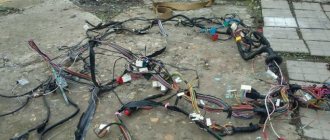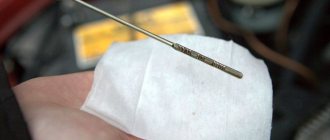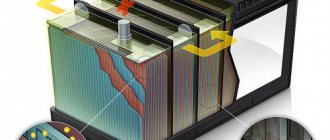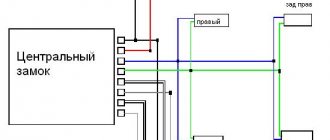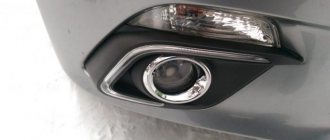01/26/2022 1,685 Generator
Author: Ivan Baranov
The design of vehicles widely uses electrical and electronic components powered by the on-board network. The voltage sources are the battery and the generator. Understanding the general operating principle of a car generator will help the car owner find and eliminate the cause of a malfunction that may occur on the road.
[Hide]
How much should the generator produce to properly charge the battery?
Often, a car generator is not able to charge the battery on board the car to 100%.
And car owners don’t always know about this, and don’t even realize it. After all, a battery charged, for example, 70-80%, can also turn the starter and power the on-board network, although weaker and for less time than a fully charged one. To control battery charging from the generator, two quantities are used:
- Voltage (V, volts).
- Current, current strength (A, amperes).
Charging the battery in a car occurs only while the engine is running, when the generator rotates and generates electricity.
In this case, the battery should receive a voltage of 13.5V -14.5V.
The second most important parameter for charging is the current in amperes. This is where misunderstandings often occur. Initially, the battery and generator on the car are selected appropriately from the factory. At the factory, they install a battery of the exact capacity that can be fully charged by the standard alternator on this car model. But if the car owner then installed a new battery of a different capacity during the change, there may be inconsistencies.
Operating modes
When operating the machine generator, there are 2 modes:
- starting the internal combustion engine - at this moment the car starter and the generator rotor coil are the only consumers, battery energy is consumed, starting currents are much higher than operating currents, so whether the car starts or not depends on the quality of battery recharging;
- operating mode - the starter is switched off at this moment, the generator rotor winding goes into self-excitation mode, but other consumers appear (air conditioning, glass heaters, mirrors, headlights, car audio), it is necessary to restore the battery charge.
Attention: With a sharp increase in the total load (audio system with an amplifier, subwoofer), the generator current becomes insufficient to meet the needs of the on-board system, and the battery charge begins to be consumed.
Therefore, to reduce voltage sags, car audio owners often install a second battery, increase the power of the generator, or duplicate it with another device.
Rice. 13 Two generators on one car
How much should the generator produce to properly charge the battery?
The balance of the battery and generator is determined by the simplest formula. The number of amps/hours of the battery is divided by 10.
For example, a car is equipped with a battery with a capacity of 100Ah. 100:10 = 10A. For a battery with a capacity of 60Ah, this figure is 6A. (60:10=6).
This is exactly the amount of current the generator must provide to recharge these batteries. For a battery with a capacity of 100Ah – 10 amperes, for a battery with a capacity of 60Ah – 6 amperes, and so on.
It is important that this ratio is relevant for charging with a generator during a trip. The charger can charge a battery removed from the car even at a current strength that is 2 times less.
For example, 3A instead of 6A for a 60Ah battery. But charging will occur twice as slow; during a trip with high energy consumption (light, climate control), the battery may simply not have time to charge. Modern chargers themselves determine the parameters of the charging current; the capabilities of the 220V network for such purposes are not limited, unlike a generator. In rare cases, the charger only has a switch for the required voltage - for batteries of 6, 12 and 24V.
Most often, a car is equipped with a battery with a larger capacity than the standard one. A battery with a smaller capacity may simply not pull the starter even when fully charged, especially in the cold season.
The dimensions of the installation site often allow this to be done, since the dimensions of batteries of different capacities sometimes differ slightly.
For example, a battery with a capacity of 72Ah has dimensions of 27.8 cm by 17.5 cm by 17.5 cm. And a battery with a capacity of 100Ah has dimensions of 35.3 cm by 17.5 cm by 19.0 cm.
The differences in the sizes of batteries with a smaller difference in capacity (70-80Ah) are almost imperceptible, or they are sometimes equal, so such replacements happen quite often.
When making such a replacement, you should check the current strength of the generator. It can be indicated in the Operating Instructions, in the technical specifications section. Also, the actual current strength can be measured with the engine running using a simple ammeter or multimeter. Such measurements of current and voltage may be required not only when replacing the battery with a more powerful one. They evaluate the generator's performance in any case. Sometimes it can work, but not to its full potential. For example, the belt slips, low speed, little energy, the battery is recharged, but not completely.
In critical cases, when the generator is completely out of order, the car owner will notice this very quickly. Firstly, according to the signal from the devices, “the battery is not charging,” etc. Secondly, because after a short distance “on one battery” the car will quickly stop.
But chronic “undercharging” can go unnoticed.
How much should the generator produce to properly charge the battery under load?
The operating voltage of the vehicle's on-board network, regardless of the load and engine speed, respectively, of the generator, is from 12V to 14V. The generator and battery work in tandem as energy sources. If there is a lack of voltage and current in the network from the generator, the battery can compensate for it. When the battery is discharged, on the contrary, the generator can charge it.
At high and low generator speeds, different amounts of energy are produced. But a stable voltage is supplied to the network, since it is equalized by the diode bridges of the generator and relay regulators.
There is no big problem with voltage drops between 12V and 14V. By analogy with 220V networks: the voltage in them can fluctuate from 180V to 240V (± 10-15%), however, all household appliances, computers, etc. work, although up to certain levels of differences.
Source
What elements does the stator of a synchronous generator consist of and the principle of operation?
Stator elements:
- Package of stator windings;
- Stator core or package;
- Wires for connection output.
The stator itself is made of three windings, three different current values are formed in them, this circuit is a three-phase output. The ends of each winding extend from the generator body (they are connected to it), the second end is connected to the rectifier. To concentrate and enhance the magnetic field in the generator, a core made of metal plates is used.
The stator winding of a synchronous generator is located in special slots, usually there are 36 such slots. In each slot, the winding is held by a wedge. This wedge is made of insulating materials.
How is a car battery charged from a generator?
When starting the car, the battery emits electric current and is discharged. When the car engine is running, the generator produces energy. The on-board electrical station of the car, when the rotor and stator windings interact, produces an alternating three-phase current. The resulting energy replenishes the battery and powers the vehicle's electrical system.
Why do you need a generator in a car?
If you want to know why a generator is needed in a car, you should first familiarize yourself with its functionality.
The car starts to move when started. When you turn the key, current from the battery goes to the starter.
The main problem is that the battery has a limited energy reserve. This is where the operating principle of a car alternator becomes very useful. The device converts kinetic energy from movement into electricity. This allows you to recharge the battery and the vehicle's electrical network.
A generator in a car is a device that produces energy even when idling. But here everything is not so simple and fast. This equipment reaches its maximum power starting from 1500 rpm. This aspect plays a key role when it comes to the principle of operation of a generator in a car.
How does a car's energy system work?
The three-phase generator produces alternating current, and the power supply is designed for direct current. Therefore, through the rectifier, energy is supplied to the battery, and from there it is distributed to consumers. If the battery does not receive energy from the generator, it will run out and the car will lose power. The battery cannot be fully charged from the car's internal network. External recharging is required periodically.
How to check if the battery is charging from the generator
Before testing the functionality of the generator, you need to make sure that the battery is in good condition. If your car battery is not charging, checking your alternator may reveal mechanical and electrical problems. In VAZ cars, engine starting problems often occur when the generator does not charge the battery sufficiently.
Types of control over the operation of the device:
- Visual inspection. If the battery does not charge, you need to carefully inspect the wiring. Be sure to clean the oxidized contacts from the generator and tighten the connecting fasteners. It is necessary to inspect the battery case - when overcharging due to the fault of the gene, the rate of battery destruction increases. Symptoms: The battery will develop a permanent coating and the charging indicator will glow red.
- After repairing the car, it would be useful to check that the generator is connected correctly by rotation. We connect an anti-fog lamp to the outputs. We apply rotation to the rotor using a drill. If the light does not light up, you need to change the polarity of the connection.
- A working generator supplies a stable voltage of 14.1 - 14.5 V. You can measure the indicator on a bench. Diagnostics is carried out using a battery and a 50 W incandescent lamp. If the glow is bright, the generator is working. This means that the reasons why the car battery is not charging need to be looked deeper.
- Greater accuracy in finding problem areas will be obtained by testing the stator and rotor separately. They are looking for an interturn short circuit or a short circuit of individual wires to the body or a poor connection of the terminals with the contacts. A short circuit is often the reason when the battery of a VAZ car is not charged from the generator.
- Checking the diode bridge for the suitability of all diodes, 3 positive and 3 negative. If at least one of the diodes is broken, the battery will show a low charge.
- The Control Ind alarm can be a signal to check the power supply system. If the car's generator and battery are working properly, the reason why there is no charge may lie in a faulty voltage relay.
Will the battery be charged from the generator if there is damage that prevents the rotor from rotating? Mechanical problems include faults in which the rotor does not spin - a torn or loose timing belt, a crumbling bearing, and the like.
Electrical diagram
Manufacturers take into account the specific number of consumers in a car model, so in each case an individual electrical circuit of the generator is used. The most popular are 8 diagrams of “mobile electrical installations” under the hood of a car with the same designation of elements:
- generator block;
- rotor winding;
- stator magnetic circuit;
- diode bridge;
- switch;
- lamp relay;
- regulator relay;
- lamp;
- capacitor;
- transformer and rectifier unit;
- battery;
- Zener diode;
- resistance.
Rice. 15 Scheme 1
In schemes 1 and 2, the exciting winding receives voltage through the ignition switch so that the battery does not discharge when parked. The disadvantage is the switching of 5 A current, which reduces the service life.
Rice. 16 Scheme 2
Therefore, in diagram 3, the contacts are unloaded by the intermediate relay, and the current consumption is reduced to tenths of an ampere. The disadvantage of this option is the complex installation of the generator, decreased reliability of the design, and the switching frequency of the transistor increases. The headlights may blink and the instrument needles may shake.
Rice. 17 Scheme 3
In circuit 5, an additional rectifier is made from three diodes on the way to the excitation winding. However, when parking for a long time, it is recommended to remove the “+” from the battery terminal, as the battery may be discharged. But during the initial excitation of the winding at the moment of starting the internal combustion engine, the battery current consumption is minimal. Extinguish the zener diode, which is dangerous for the electronics of the machine.
Rice. 18 Scheme 5
For diesel engines, generators using circuit 6 are used. They are designed for a voltage of 28 V; the exciting winding receives half the charge due to connection to the “zero” point of the stator.
Fig 19 Scheme 6
In diagram 7, the discharge of the battery during long-term parking is eliminated by reducing the potential difference at the “D” and “+” terminals. An additional wing of the rectifier diode bridge was created from zener diodes to eliminate voltage surges.
Rice. 20 Scheme 7
Scheme 8 is usually used in Bosch generators. Here the voltage regulator is complicated, but the circuit of the generator itself is simplified.
Rice. 21 Scheme 8
How long does it take to charge a battery from a generator?
The generator and battery must comply with the technical parameters. A full battery charge is enough for several attempts to start the engine with a break between turns of the starter. In this case, the battery does not receive recharge and may be completely discharged.
How long does it take for the car's alternator to charge the battery? Considering that energy replenishment should not be more than 10% of the battery capacity - quite a long time. The supplied energy is immediately used to recharge operating devices. And only the energy reserve replenishes the battery capacity. How long will it take for a battery that is dead when starting the engine to be charged from the generator?
If the power of the generator matches the capacity of the installed battery, the on-board power plant generates 10% of the energy from the battery capacity. How long does the drive need to charge? If its capacity is 60 A/h, then the generator must produce a current of 6 A, excluding consumers. Therefore, the generator power must be greater to compensate for losses, and service devices are selected comparable to the capabilities of the power unit.
If the battery is not charged from the generator, the reason may be a large number of consumption sources that can take up to 80 A. If the generator’s power is insufficient, or it is faulty, will the battery be charged from it? It is necessary to turn off some of the service equipment - media center, air conditioner and the like.
What is a generator in a car?
So, why do you need a generator in your car?
The generator has been used almost since the very beginning of the automobile industry. However, at that time, only DC generators were available to engineers. The design of a car generator of this type was characterized by unstable operation and a very small amount of power.
Everything changed in the 60s of the twentieth century. Selenium and silicon semiconductors appeared on the market, which allowed engineers to create a new invention - alternating current generators. The new device had less weight (several times). Another benefit was efficiency. At the same load, the car's alternator produced electricity more stably and distributed it between the on-board network and the battery. Over the course of several years, the device has changed dramatically. The equipment has become more powerful, more reliable and more stable.
How long does it take to charge a car battery from a generator?
How long it takes to charge a car battery from a generator is an imperial indicator. It depends on the ease of starting - how many times the starter was turned. The remaining charge of the battery after a long period of parking varies, as do the temperature conditions. Therefore, restoration of battery capacity depends on the technical parameters of the generator, at what speed it produces current, and how many additional devices are powered.
However, it is known that in order to restore the battery’s ability to start the engine, you need to idle and drive at average speed for at least 20 minutes. To fully restore capacity, it will take at least 3 hours of continuous vehicle movement.
How long a battery is charged from a car generator depends on the ambient temperature and the condition of the battery. But as the electrolyte heats up, the chemical process proceeds faster and less external energy is required. How quickly the charge accumulation process occurs depends most on how long the generator operates. Therefore, on long-distance vehicles, batteries are rarely charged from the network.
How much should the generator produce to properly charge the battery?
Constant undercharging of the battery or its absolute discharge at the most inopportune moment is a headache for many car owners. One source of these problems may be the generator. But how to check it? Perhaps it's not his fault at all? Let's figure out together how much the generator must produce for the normal functioning of all car systems and maintaining the battery in a charged state.
How to check the operation of the generator
The battery in a car is an important element of the system, which is responsible for providing the car’s on-board network with electricity. The generator is used to charge the battery while it is active. Unstable operation of a device generating electricity causes a voltage drop in the network and failure to restore the capacity of the power source.
Normal generator performance means timely and complete replenishment of the battery charge level, which decreases under load. Checking the battery charge level from the generator is simple and can be done by the car owner himself.
Diagnostics of an automotive energy-generating device includes a visual inspection of the unit, its elements and related parts, as well as voltage and current measurements. At least twice a year, you should check the tension of the drive belt, excessive weakening of which leads to a decrease in the performance of the generator, and sometimes can lead to breakdown of the device. Once a year, you can check equipment elements - fasteners, diode bridge, voltage regulator and others. Timely maintenance of the battery will also guarantee the absence of problems - cleaning the terminals, adding distilled water.
Diagnostics of indicators such as voltage, current, resistance are also necessary twice a year. To carry it out, you will need special devices - a voltmeter, multimeter or load fork.
Useful tips
Recommendations that will be useful during operation and maintenance of the battery to extend its operating time:
- test the battery from time to time and recharge it from the mains as often as possible (at least once a quarter);
- Make sure that the generator, wires, and car voltage regulation functions are in good condition to ensure the battery is properly charged while traveling;
- measure current leakage;
- measure the density of the electrolyte substance after full charging, compare the numbers from the table above, correct the situation if necessary;
- Keep your car battery clean to minimize leakage current.
Do not short-circuit the output terminals of a car battery, as the consequences in this case will be disastrous.
What kind of charging should go to the battery from the generator?
It is traditionally believed that 13.5-14.5V should be supplied by the generator to the battery and this is absolutely enough to replenish the battery costs.
It is worth considering that using a battery with a higher power in a car than the manufacturer recommends also requires the installation of a more productive generating device.
It is necessary to take into account the load that the generator must withstand - it is calculated based on the maximum indicators of all electrical appliances and car systems.
Do not forget that the charging current from the energy-generating device will allow you to start the car in the cold season. In order to avoid problems with starting the car, we recommend purchasing generating equipment, the charge current of which will be approximately 10% of the capacity of the power source. That is, a battery of 100 A/h requires a generator that can produce 10A. Please note that for many cars, 100 amp equipment will operate at its maximum capacity, because the power consumption of the automotive system is in the region of 80 amps. Therefore, the choice of a source generating energy must take into account both the battery capacity and network consumption.
How to check the alternator voltage on the battery
The potential difference can be diagnosed in two ways - directly at the generating equipment and through the battery. The generator is directly connected to the power source with a thick wire, therefore, to check the level of potential difference, you can measure the voltage at the power source. To do this, you will need special devices - a voltmeter, multimeter or load plug.
The wires of the first measuring instruments are connected to the battery in any sequence. The plug must be connected to the battery terminals with strict observance of polarity. It is generally accepted that the normal voltage in the network should not be lower than 12 volts. At idle speed without turning on all the electrical appliances of the car, this indicator should be at the level of 13.5-14V. A drop in voltage values to 13.3-13.8 volts is considered acceptable.
At the same time, using conventional testing equipment, you can check the resistance of the generator elements - rotor, stator and diode bridge. Diagnostics of rotary equipment is carried out by its winding. It is necessary to connect the probes of the device with slip rings. If the multimeter gives readings from 2, 3 to 5.1 ohms, then this element is working. The current consumption of the winding should be within 3-4.5 amperes.
Other causes of low voltage
A small potential difference in the system is not always associated with a breakdown of the generator or a bad battery. If the diagnosis of these elements does not reveal any problems, then you should pay attention to the following:
- condition of the battery terminals - connection density and oxidation;
- electrical wiring problems - oxidation, violation of its integrity;
- output contacts to electrical appliances;
- correctly selected energy consumers.
Each contact must be tightly adjacent and intact, that is, there must be no formations (for example, sulfation) that will disrupt the flow of current. Incorrect connection of contacts leads to accelerated battery discharge even when the car is not running.
To improve the connection of the elements of the car's electrical system, it is necessary to clean all contacts and restore the integrity of the wires by replacing them or connecting them and wrapping them with insulating tape.
How many amperes does a car alternator produce per battery?
The current strength required by the electrical system of each car is individual and depends on the number of electricity consumers and their values. And also the charge current must be sufficient to charge the power source.
It is worth noting that ampere readings appear only when there is a load in the vehicle’s electrical system and, accordingly, the battery is discharged. After starting the car engine, the charging current is about 6-10 amperes and drops over time, because the battery is charging, taking on the main energy consumption. If you turn on additional equipment - headlights, radio or heated mirrors, you can see an increase in the charging current values.
When purchasing a generator, pay attention to its technical characteristics, which the manufacturer indicates on the case - that’s where you will find information about the maximum current that will flow to the battery.
In the table below you can see the approximate current values that the generator shows at different loads.
Table 1. How many amperes the generator produces under load.
Step-by-step procedure for checking the generator
- Turn on the ignition and make sure that all the dashboard lights are on.
- We start the car, and if the generator is operating normally, the battery warning light should go out.
- We wait until the car warms up to its standard operating temperature of 90 °C.
- When it warms up, it is necessary to load the network as much as possible. To do this, we turn on everything that is in the car, including heated mirrors, lights, music, etc.
- We take a pre-prepared multimeter and set it to the “voltage” check mode.
- Next, we call an assistant and ask him to keep the engine speed at idle (within 3500 - approx.).
- Using a multimeter, we connect its probes to the battery, and at the moment when all consumers are turned on, the readings should not fall below - 13-13.2 V.
If the readings are lower at such engine speeds, this will indicate that the generator is not producing the required amount of energy. And when they are normal, we continue testing with switched off consumers at the same speed. In this case, the multimeter readings should be about 14.5-14.7 V.
Checking the voltage supplied by the generator
After diagnosing the battery, we go directly to the generator using the same multimeter.
- When the car is started, we connect the probes to its terminals, and the voltage should be at least 14-14.3 Volts.
- Next, as the speed increases, we monitor the instrument readings, where the values should not change by more than 0.5 volts. If this is not observed, this will mean that the generator and voltage regulator are functioning correctly.
There is an excess of overvoltage in the network.
Now, having reliable information about how many volts the generator should produce, you will know for sure whether it is working or not. And if the readings differ slightly from the norm, then first of all you should pay attention to the malfunctions described below.
Signs of a generator malfunction
In modern cars, breakdowns of the electrical system are one of the most common. A large number of electronics requires particularly careful monitoring of the operation and condition of the generator and battery, because their failure can immobilize the car. The most common signs of a generator malfunction are:
- battery indicator light on the instrument panel;
- unstable operation of the battery (its boiling over or undercharging);
- different intensity of headlights;
- extraneous sounds from the generator.
If you notice incorrect operation of the car, then perhaps the battery charging current from the generator is insufficient.
All malfunctions of electrical equipment, which includes the vehicle’s energy-generating device, are mechanical (deformation or breakage of fasteners, housing, malfunction of bearings, pressure springs, drive belt, etc.) or electrical (winding breaks, diode bridge malfunctions, burnout or wear of brushes , short circuits between turns, breakdowns, etc.).
Don’t write off a non-working generator: find out if there are repair kits and spare parts. Replace them if possible. If you cannot carry out repair work yourself, then take the generator to a workshop. Many craftsmen will be able to restore the unit at no extra cost and in the shortest possible time.
However, some breakdowns require the purchase of a new device that generates electricity. For example, a failing bearing that is soldered into the generator housing cannot be restored or replaced in most cases.
Remember that failure of this unit can be caused not only by wear and corrosion, but also by poor quality of elements and components; excessive load; external influence of salts, liquids, temperatures.
Alternating current generator device
The operation of any generator can be compared to an electric motor that operates in reverse mode, that is, it does not consume, but produces current. Based on the type of design, modern generators are divided into two types: compact and traditional. They have a common device, but differ in the layout of the housing, fan, rectifier assembly and drive pulley. Also, modern devices have three phases.
The generator consists of the following main elements:
- drive with pulley, bearings and shaft;
- rotor with field winding and slip rings;
- stator with core and winding;
- a housing consisting of two covers;
- voltage regulator;
- rectifier block or diode bridge;
- brush assembly.
Let's analyze each element of the device separately and in detail.
Frame
The housing contains all the main elements of the generator. It consists of two covers (front and back). The covers are connected to each other with bolts. For the manufacture of covers, light aluminum alloys are used, which are not magnetized and dissipate heat well. The covers have ventilation holes and mounting flanges.
The back cover contains a diode bridge and a brush holder with brushes. Also in the back cover there is an output contact through which current flows from the generator.
